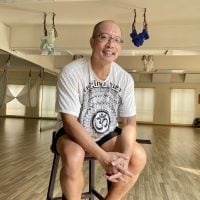View this post on Instagram
There was a time when the thought of learning philosophy would have brought tears of boredom to my eyes.
Still, I had to go through yoga philosophy for my yoga teacher training in 2013, and since then, I can’t imagine anything more nurturing to practice for my daily life.
Here’s an example why:
Accidents happen.
Once, as a bootcamp coach, I had to leave my home at 11 p.m. to get to the beach to coach a six-hour fitness challenge. I finished my last session at nine in the evening in a neighbouring town. I had to rush home, inhale my dinner, and then head to the beach (about a two-hour drive away). As I was hauling my stuff into the trunk of the car, the lid fell on my head due to a faulty spring.
I recall telling my partner (who was coming with) that I was fine. I would just slap on a Band-Aid and head to the beach. But when my vision got blurry due to the blood from the wound in my forehead, I realised I wasn’t that fine. My partner firmly said, “I’m taking you to the doctor.”
Before I knew it, I was sitting patiently in a private clinic. “Come on, come on, I need to get to work,” I kept thinking. The doctor proclaimed I needed stitches, and so I was taken to another room where a nurse prepped all the stuff for the procedure.
To be honest, the wound on my forehead wasn’t that painful. In fact, knee grazes from bicycle falls probably hurt more. But the nurse and my partner were exchanging notes on how appalling the wound looked.
As the local anesthetic was injected (which I felt), the conversation was all about pain. If the wound didn’t hurt before, it began to hurt a lot as the nurse and my partner had an animated exchange about their most painful experiences. If I wasn’t as stressed as I was, I would have contributed that my most painful experience was listening to them comparing painful experiences while I was getting my forehead stitched!
Anyway, at that time (almost 10 years ago now), I was undergoing my yoga teacher training. And one thing my guru, Manoj Khaimal, always encouraged us to do was to discern and do the most skillful thing in the moment. So, I focused on my breath.
It was strange but the more I held on to my breath, the less clear their conversation became. In fact, their words faded, and all I could hear was the sound of my breath. The sensation of the needle threading my brow faded as well, and I remember immersing in breath. There was just me and my breath in this fluorescent-lit, sterile room at close to midnight.
Before I knew it, my forehead had eight stitches and I was all bandaged up and ready to head the beach to help clients endure six hours of non-stop, muscle-busting bootcamp pleasure.
Yoga philosophy in practice.
To simplify, in any one experience, there are many points of focus. The main point of experience for us is vrtti, or the known experience. The causative force of the vrtti is called pratyaya. And my experience of the experience is chitta.
So when I was sitting there in that clinic, and as I waited for and went through the stitching, I was experiencing the stress of having to get to the beach on time for work, the pain in my forehead due to the wound, the conversation between my partner and the nurse about their most painful experiences, the cold of the metal seat I was on, and a whole slew of other experiences I could have chosen to focus on.
For example, I could have chosen to focus on the stress of running late for work. I am easily stressed and have a tendency to dwell on it until it becomes a full-grown monster. In hindsight, I think I felt less pain from that wound because of the amount of stress I was placing myself under. But focusing on the pain wouldn’t have served me.
Alternatively, I could have focused on the pain, as I have a low threshold for it. The conversation about painful experiences dulled the stress but intensified the pain, so moving to focus on that aspect of the experience would have served me far less.
That left me with the breath. As I drew all my attention, all my focus to my breath, the stress dissolved, the pain reduced, and the conversation about pain became muffled. At one point, everything seemed to dissolve, leaving me with just the breath.
Yoga off the mat.
According to Yogapedia:
“On the path to union with the Divine, the yogi first begins with many thoughts or impressions, which are gradually reduced to a single pratyaya or thought. At this point, the yogi has reached the state of meditative awareness. In this context, pratyaya is the object of meditation.
In dharana (concentration and perceptual awareness), the sixth of Patanjali’s eight limbs, the yogi learns to prevent other thoughts from intruding on his/her efforts to focus on the pratyaya.”
This is what happened to me as I sat there waiting to get to work while my forehead was getting stitched.
And this is how yoga philosophy helps. It is the example I use to explain how practical yoga philosophy is in our daily life, and how liberating it is for us to have these tools to survive and thrive.
I cannot count the number of times concepts and ideas from yoga have helped me make it through the day, especially during these past few years of a pandemic and lockdowns. The philosophy goes beyond the yoga mat and should be the takeaway from our yoga practice.
~











Read 0 comments and reply